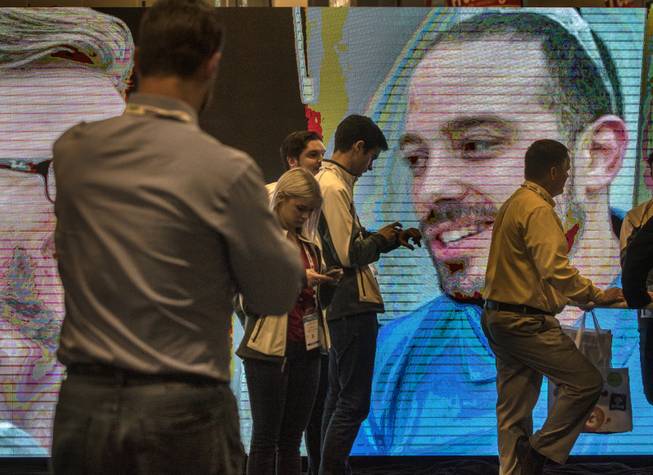
Attendees stream about the National Automatic Merchandising Association Show within the Venetian Convention Center on Thursday, April 20, 2017.
Saturday, April 22, 2017 | 2 a.m.
The days of dropping a few coins in a vending machine, making your selection and yanking your choice behind the metal door at the bottom could be nearing an end.
The National Automatic Merchandising Association (NAMA) displayed the latest and greatest in the vending machine world at this year’s NAMA OneShow, which ended Friday at the Venetian Convention Center.
The $25 billion industry is focusing on technology that makes the experience quicker and more efficient for both customers and retailers. App-based ordering, hands-free inventory, digital touchscreens, safety improvements and other advancements were on display.
PepsiCo’s Hello Goodness
The focal point for PepsiCo Inc. both last year and this year is its Hello Goodness brand.
The brand is made up of healthier options, including a line of baked chips, mixed nuts, energy and protein bars, as well as drinks that don't have excessive amounts of sugar or are fruit- or vegetable-based.
Customers looking to avoid the fried potato chips-and-soda combo found in typical vending machines are demanding healthier options.
“It’s choices that people feel good about,” said David Lothian, senior director of global vending sales for PepsiCo. “It’s choices that gives them the right amount of energy to focus or it's something that makes them feel good, without the guilt of buying a chocolate bar and items like that.”
PepsiCo has 21,000 more traditional Hello Goodness machines on the market now, with an updated one coming out this year.
The new model is a dual machine that has food options on one side and beverage options on the other, with a large touchscreen-ordering menu in the middle. The screen allows customers to pair food and beverage items to create a quick snack meal.
“Not only do they want healthier choices, they also want a better user experience,” Lothian said. “I want to be able to pay with my credit card, I want to be able to pay with my watch. All the machines with Hello Goodness come fully equipped with all the payment options needed with today's consumers.”
Customers can look up nutritional information on the touchscreen, create a basket of items and more.
“Technology is really enabling us to do something different,” he said. “Consumers have responded very well.”
Sensor Swarm
Keeping perishable foods at a safe temperature is key to the health of customers purchasing the items and the bottom line of the retailer. Spoiled items mean lost revenue.
Sensor Swarm is a palm-sized device that retailers can place in refrigerated compartments to keep up-to-date on the status of all their units. The real-time aspect allows problems to be addressed as soon as possible.
Sensor Swarm sends data via the internet so retailers can keeps tabs at all times.
The device’s size allows retailers to install them in the coolers, vending machines and trucks that are transporting the items to keep track of the food and its temperature each step of the way.
“It sends the food temperature to the cloud so it can be analyzed graphically,” said Dale Szymborski, president of SensorSwarm. “You can set up different profiles for different assets. They have different temperature requirements.”
With an increasing amount of state and local municipalities asking retailers to keep detailed temperature logs, SensorSwarm takes a lot of the work out of the process, while ensuring the retailer has the proper temperature history logs, Szymborski said.
“We are able to send alarms via email and text to those who need to know when the state of the food is compromised,” Szymborski said.
Viv
With more retailers accepting alternate forms of payment, including app-based ordering, it was just a matter of time before the vending machine industry dove into the app realm.
Viv, a cashless hardware-based system, uses its smartphone app to allow customers to place orders and pick their snacks up at a vending machine they choose. If the Viv machine isn’t in the customer's building, GPS shows users where the closest Viv machine is located.
Through the app, Viv machines accept all major credit cards, PayPal, ApplePay, AndroidPay and even Bitcoin.
Once the customer reaches their desired machine, the order goes through, the payment is confirmed and the item drops without the customer ever touching the machine.
“We’re all about interacting with the consumer,” said Hector Benavides, vice president of business development with Vagabond Vending. “The consumer could be at their desk, they could be walking through the park, turn on the app and find machines with GPS. We’re tied in with Google Maps.”
Once a machine runs out of a product, it will no longer show in the app, minimizing customer inconvenience.
Users can also view nutritional facts of the products in the machine on the app, which can save a company hundreds of dollars to add a screen to display such data, according to Benavides.
The app also helps operators by tracking products in the machines in real time, so they know exactly when a certain product is getting low at a specific machine. The system also eliminates cash thefts.
Wizzan Mobility
Wizzan Mobility’s RouteSight software uses Google Glasses to speed up the process of servicing warehouses.
Handheld scanners or tablet-style devices are usually used to track inventory, which can slow up the service time. The technology includes visual direction and audio prompts, allowing confirmation of inventory faster and more accurately.
“This keeps people who are handling product all day hands free,” said Andrew Sapp, chief technology officer at Wizzan Mobility. “It allows them to do the data interaction while they’re actually handling the product, because usually that’s separate and not as efficient.”
The idea behind RouteSight is to keep the employee in the workflow without worrying about the data. All collected data are stored and synced to the warehouse via Wi-Fi, which also takes a step out of the manual entry model.
Drop Water
Typically water bought out of a vending machine comes in a plastic bottle that often not recycled or ends up being littered.
Drop Water, created by Scott Edwards, uses tap water from any city, runs it through a filter and then gives the consumer the ability to customize their water.
“Locally sourced water water is everywhere, where do we need to bring it all the way in from Fiji, moving it all the way across the world,” said Edward Hooper, head of business development for Drop Water.
Using a touchscreen on the unit, customers can choose to add one of four flavors, spring cactus, garden mint, cool cucumber, Kensington Mango or choose to keep their water pure. The option to have your water cold or room temperature is also available.
Additionally, different levels of caffeine can be added to the water, which is then dispersed in a cardboard carton that is entirely biodegradable, even the cap.
“Our owner is big into the ocean, and he was sick of these plastic bottles being littered in the environment. So he came up with the idea of making the bottle out of totally decomposable material,” Hooper said.
The biodegradable bottles can be customized for different establishments or events, creating an interactive user experience. All custom bottles are done with soy ink.
The machine also has a spout for those who have their own container and want to fill it up at their machine.
The company’s goal is to deliver a quality product while creating the least amount of impact on the environment as possible, Hooper said.


Join the Discussion:
Check this out for a full explanation of our conversion to the LiveFyre commenting system and instructions on how to sign up for an account.
Full comments policy